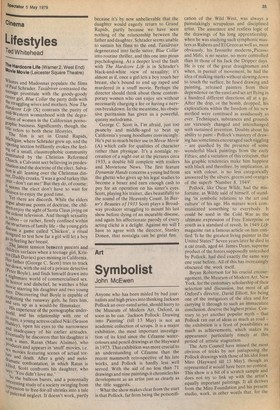Art
Symbolist
John McEwen
Anyone who has been misled by bad journalists and high prices into thinking Jackson Pollock an over-rated artist, should hurry to the Museum of Modern Art, Oxford, as soon as he can. 'Jackson Pollock: Drawing into Painting' (till 13 May) is not an academic collection of scraps. It is a major exhibition, the most important investigation of its kind since the Caanne watercolours and pencil drawings at the Hayward in 1973. That exhibition was more crucial to an understanding of C6z.anne than the recent mammoth retrospective of his late works, and Pollock is hardly less well served. With the aid of no less than 71 drawings and nine paintings it chronicles his development as an artist just as clearly as the title suggests. What the show makes clear from the start is that Pollock, far from being the personifi cation of the Wild West, was always a painstakingly scrupulous and disciplined artist. The assurance and restless logic of the drawings of his long apprenticeship, when he was studying such symphonic masters as Rubens and El Greco as well as, most obviously, his favourite moderns ,Picasso and Mifo, is no neater, no more controlled than in those of his Jack the Dripper days. He is cne of the great draughtsmen and when, in pursuit of movement, he had the idea of making marks without slowing down to touch the surface, he fused drawing and painting, released painters from their dependence on the easel and set art flying in a hundred different directions all at a go. After the drip, or the bomb, dropped, his explorations within the freedom of his new method were continued as assiduously as ever. Techniques, substances and grounds are variously changed and interchanged with sustained invention. Doubts about his ability to paint — Pollock's mastery of drawing has sometimes encouraged such niggling — are quashed by the presence of some wonderful black paintings from the early Fifties; and a variation of this criticism, that his graphic tendencies make him happiest with black and therefore, by implication, at sea with colour, is no less categorically answered by the silvers, greens and oranges of the superb 'Number 8, 1949'.
Pollock, like Oscar Wilde, had the misfortune, as Wilde said of himself, of standing 'in symbolic relations to the art and culture' of his age. His mature work communicated something to everybody. It could be used in the Cold War as the ultimate expression of Free Enterprise or youth as a standard of revolt. In 1949 Life magazine ran a famous article on him entitled 'Is he the greatest living painter in the United States?' Seven years later he died in a car crash, aged 44. James Dean, supreme product of the forces supposedly unleashed by Pollock, had died exactly the same way one year before. All of this has increasingly obscured the work itself.
Bryan Robertson for his crucial encouragement, the Museum of Modern Art, New York, for the customary scholarship of their selection and discussion, but most of all Oxford's director, David Elliott, for being one of the instigators of the idea and for carrying it through to such an immaculate conclusion, deserve the highest praise. Contrary to yet another popular myth — that Pollock ran out of ideas as much as road — the exhibition is a feast of possibilities as much as achievements, which makes its appearance particularly timely at this period of artistic stagnation. The Arts Council have missed the most obvious of tricks by not juxtaposing the Pollock drawings with those of his idol Joan Miro (Hayward till 13 May), though as represented it would have been no contest. This show is a bit of a scratch sample and does not try to link up with the artist s equally important paintings. It all derives from the Miro Foundation and his present studio, work, in other words that, for the most part, he has been unable to sell, and it looks it. After the standard set by his paintings in last year's great surrealist exhibition and the unforgettable animation of his symbols by the La Claca theatrical troupe even more recently, perhaps any Miro show would have been too much. The present one has its moments inevitably — there are some particularly good drawings in the cases—but basically it is a filler.
Many people by now must also have just about had their fashionable fill of Mughal Indian painting, so it says a lot for Michael Goedhuis's selection at Colnaghi's (till 19 May) that, if not comparable to the Gallery's recent shows of this art, notably that of the great Rothschild collection three years ago, it still bears considerable scrutiny. Because of their poor condition and apparent lack of refinement, some of the best things in the exhibition, both for their rarity and energy, might be overlooked by someone shopping rather than looking. There are four particularly fine early examples of popular Mughal art on the left as you enter, for instance, and in the main gallery, from much the same 16thcentury time, the show-stopper: one of the surviving 150 leaves from the liamzanama', the first great venture of Akbar's artists. An excellent catalogue introduction by Michael Goedhuis places the art in its historical context, and there are scholarly notes to each painting by Toby Falk and Simon Digby.











































 Previous page
Previous page